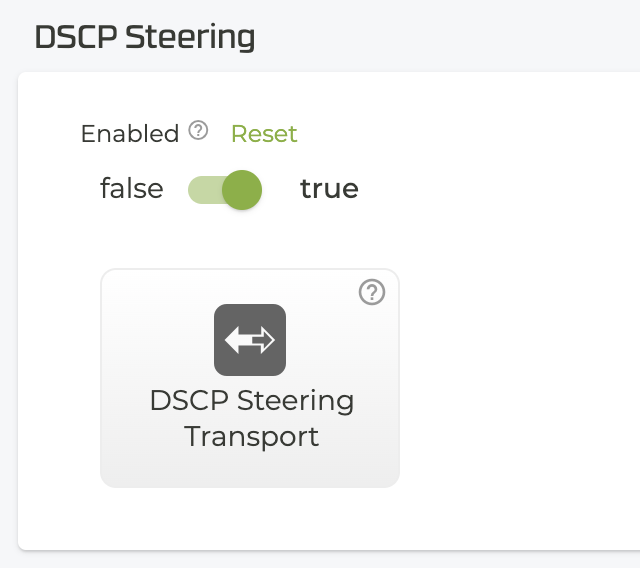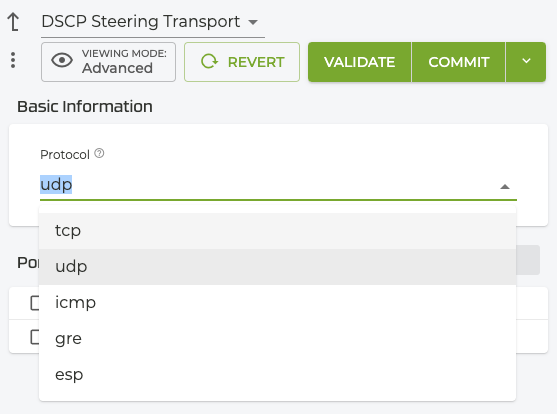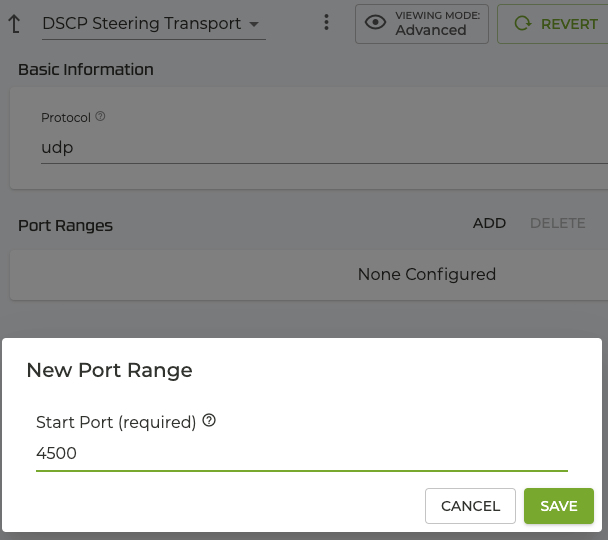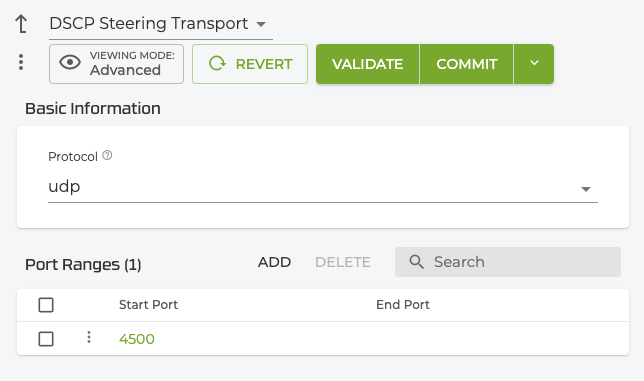Configuring DSCP Steering
When traffic is traversing an IPSec encrypted tunnel, every flow within that tunnel shares the same layer 3 headers, making them difficult to identify.
To provide identification and aid in load balancing and traffic engineering, DSCP values can be set at the tunnel endpoint. When the traffic reaches the SSR, the DSCP value is used for both traffic engineering priority and path priority for DSCP traffic steering.
Beginning with SSR version 6.1.4, DSCP Steering is now enabled for BGP over SVR tunnels. Using the configuration below, and configuring BGP over SVR, the child service configured for DSCP steering is now recognized and steered appropriately.
Basic Configuration
- Configure the ingress interface for
dscp-steering - Configure a parent service that matches the traffic profile of the tunnel
- Configure a child service that defines the
dscp-rangeto steer
Example Config
Configure the network-interface for dcsp-steering:
network-interface foo
name foo
global-id 12
vlan 0
dscp-steering
enabled true
transport
protocol udp
port-range
start-port 4500
exit
exit
exit
exit
Configure the parent service for the tunnel:
service tunnel
name tunnel
description "IPSec Tunnel"
scope public
security internal
address 5.5.5.100/0
access-policy red
source red
permission allow
exit
exit
Configure the child service with the dscp-range:
service high-priority.tunnel
name high-priority.tunnel
description "The high priority traffic within this tunnel"
scope public
security internal
dscp-range 14
start-value 14
exit
exit
How it Works
DSCP traffic steering is configured on the network-interface to identify the protocol and port, and the service, to identify the DSCP values used to steer the traffic.
Network Interface Configuration
Configuring dscp-steering at the network-interface level focuses DSCP traffic steering on a specific transport protocol and port range, rather than an entire interface.
Only traffic matching the dscp-steering properties configured on the network-interface and in the service is steered using DSCP. Other traffic is handled according to the relevant configuration.
The following example is designed to target IPSec NAT traversal traffic which is typically UDP, with a destination port 4500.
network-interface foo
name foo
global-id 12
vlan 0
dscp-steering
enabled true
transport
protocol udp
port-range
start-port 4500
exit
exit
exit
exit
When steering ESP traffic, ports are not specified. For example:
network-interface foo
name foo
global-id 12
vlan 0
dscp-steering
enabled true
transport
protocol esp
exit
exit
exit
exit
DSCP steering was designed with IPSec use cases in mind. Traditionally IPSec uses ESP or UDP (for NAT-T) as transport, and the examples provided are the recommended configuration.
Service Configuration
A DSCP value and range is configured for a child service; this identifies the priority and handling of the traffic at the router. DSCP aware services are configured in a hierarchy; DSCP values are not configured on the parent service.
The following example configuration splits the tunnel across 3 services. Traffic with dscp-range value 14 is handled by the high-priority service; traffic with dscp-range values from 26 to 28 is handled by the low-priority service. The remaining traffic falls back into the parent tunnel service.
service tunnel
name tunnel
description "IPSec Tunnel"
scope public
security internal
address 5.5.5.100/0
access-policy red
source red
permission allow
exit
exit
service high-priority.tunnel
name high-priority.tunnel
description "The high priority traffic within this tunnel"
scope public
security internal
dscp-range 14
start-value 14
exit
exit
service low-priority.tunnel
name low-priority.tunnel
description "The low priority traffic within this tunnel"
scope public
security internal
dscp-range 26
start-value 26
end-value 28
exit
exit
Restrictions
- The DSCP steering transport list for a network-interface is limited to one range.
- Any service with a
dscp-rangeconfiguration must be a child service. - Only provisioned service-routes are supported.
- DSCP steering ranges must not overlap.
GUI Configuration Screens
The following screens demonstrate configuring DSCP steering on the network interface using the GUI.
- Enable DSCP Steering, and select the DSCP Steering Transport button.

- Select a protocol.

- Enter the port or port range.

- Select Validate and Commit.
